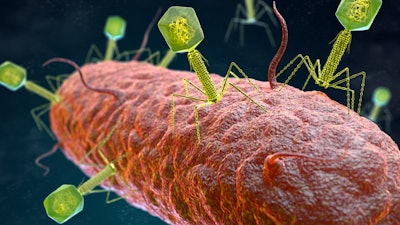
As the world fights the SARS-CoV-2 virus causing the COVID-19 pandemic, another group of dangerous pathogens looms in the background. The threat of antibiotic-resistant bacteria has been growing for years and appears to be getting worse. If COVID-19 taught us one thing, it’s that governments should be prepared for more global public health crises, and that includes finding new ways to combat rogue bacteria that are becoming resistant to commonly used drugs.
In contrast to the current pandemic, viruses may be be the heroes of the next epidemic rather than the villains. Scientists have shown that viruses could be great weapons against bacteria that are resistant to antibiotics.
I am a biotechnology and policy expert focused on understanding how personal genetic and biological information can improve human health. Every person interacts intimately with a unique assortment of viruses and bacteria, and by deciphering these complex relationships we can better treat infectious diseases caused by antibiotic-resistant bacteria.
Replacing antibiotics with phage
Since the discovery of penicillin in 1928, antibiotics have changed modern medicine. These small molecules fight off bacterial infections by killing or inhibiting the growth of bacteria. The mid-20th century was called the Golden Age for antibiotics, a time when scientists were discovering dozens of new molecules for many diseases.
This high was soon followed by a devastating low. Researchers saw that many bacteria were evolving resistance to antibiotics. Bacteria in our bodies were learning to evade medicine by evolving and mutating to the point that antibiotics no longer worked.
As an alternative to antibiotics, some researchers are turning to a natural enemy of bacteria: bacteriophages. Bacteriophages are viruses that infect bacteria. They outnumber bacteria 10 to 1 and are considered the most abundant organisms on the planet.
Bacteriophages, also known as phages, survive by infecting bacteria, replicating and bursting out from their host, which destroys the bacterium.
Harnessing the power of phages to fight bacteria isn’t a new idea. In fact, the first recorded use of so-called phage therapy was over a century ago. In 1919, French microbiologist Félix d'Hérelle used a cocktail of phages to treat children suffering from severe dysentery.
D'Hérelle’s actions weren’t an accident. In fact, he is credited with co-discovering phages, and he pioneered the idea of using bacteria’s natural enemies in medicine. He would go on to stop cholera outbreaks in India and plague in Egypt.
Phage therapy is not a standard treatment you can find in your local hospital today. But excitement about phages has grown over the past few years. In particular, scientists are using new knowledge about the complex relationship between phages and bacteria to improve phage therapy. By engineering phages to better target and destroy bacteria, scientists hope to overcome antibiotic resistance.
Engineering phages
Even if you are not a biologist, you may have heard of one type of bacterial immune system: CRISPR, which stands for Clustered Regularly Interspaced Short Palindromic Repeats. This immune system helps bacteria store genetic information from viral infections. The bacteria then use that information to fight off future invaders, much as our own immune system can recognize a particular pathogen to fight off infection.
CRISPR proteins in bacteria locate and cut specific sequences of DNA or RNA found in viruses. Such precise cutting also makes CRISPR proteins efficient tools for editing the genomes of various organisms. This is why the development of CRISPR genome-editing technology won the Chemistry Nobel prize in 2020.
Now scientists are hoping to use the knowledge about CRISPR systems to engineer phages to destroy dangerous bacteria.
When the engineered phage locates specific bacteria, the phage injects CRISPR proteins inside the bacteria, cutting and destroying the microbes’ DNA. Scientists have found a way to turn defense into offense. The proteins normally involved in protecting against viruses are repurposed to target and destroy the bacteria’s own DNA. The scientists can specifically target the DNA that makes the bacteria resistant to antibiotics, making this type of phage therapy extremely effective.
The bacteria Clostridioides difficile is an antibiotic-resistant strain of bacteria that kills 29,000 people in the U.S. every year. In one demonstration of this CRISPR-based technique, researchers engineered phages to inject a molecule that directs the bacteria’s own CRISPR proteins to chew up the bacteria’s DNA like a paper shredder.
CRISPR isn’t the only bacterial immune system. Scientists are discovering more using creative microbiology experiments and advanced computational tools. They have already found tens of thousands of new microbes and dozens of new immune systems. Scientists hope to find more tools that could help them engineer phages to target a wider range of bacteria.
Beyond the science
Science is only half of the solution when it comes to fighting these microbes. Commercialization and regulation are important to ensure that this technology is in society’s toolkit for fending off a worldwide spread of antibiotic-resistant bacteria.
Multiple companies are engineering phages or identifying naturally occurring phages to destroy specific harmful bacteria. Companies like Felix Biotechnology and Cytophage are producing specialized bacteria-killing phages to replace antibiotics in human health and agriculture. BiomX aims to treat infections common in chronic diseases like cystic fibrosis and inflammatory bowel disease using both natural and engineered phage cocktails. Thinking globally, the company PhagePro is using phages to treat cholera. These deadly bacteria affect people primarily in Africa and Asia.
Alongside the commercialization of phage therapy, policies that facilitate safe testing and regulation of the technology are vital. To avoid replicating America’s poor COVID-19 response, I believe the world must invest in, engineer, and then test phage therapies. Proactive planning will help us combat whatever antibiotic-resistant bacteria might spread.
This article is republished from The Conversation under a Creative Commons license. Read the original article here: https://theconversation.com/engineered-viruses-can-fight-the-rise-of-antibiotic-resistant-bacteria-154337.






















